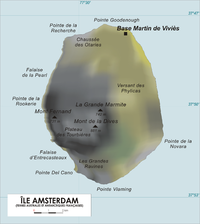

Amsterdam Island cattle were a rare feral breed of cattle (Bos taurus) that were introduced in 1871 and existed in isolation on Amsterdam Island, a small French territory in the southern Indian Ocean. The population was eradicated in 2010 in the course of an environmental restoration program.
YouTube Encyclopedic
-
1/2Views:28 729438
-
Adam's Farm Countryfile 09 09 2012
-
Feral Cattle Ngong Ping Lantau Hong Kong
Transcription
History
A party led by Heurtin, a French farmer (sometimes described as a peasant) from Réunion island, on 18 January 1871 attempted to settle the uninhabited 55 km2 island. After seven months, their attempts to raise sheep and cattle and grow crops had been unfruitful and they departed on 19 August, abandoning their livestock, including five cattle, on the island.[1]
Over the next century or so a combination of factors caused further ecological devastation of the island, which had already been impacted by the introduction of invasive species of plants and animals, as well as by unrestricted hunting, timber-cutting and wildfire caused by sealers and other visitors. The Amsterdam duck and several species of petrel became extinct, and the breeding population of the endemic Amsterdam Island albatross, previously thought to be a subspecies of the wandering albatross, was reduced to just five pairs.[2]
When the native Phylica arborea (syn. Phylica nitida) forest was almost entirely destroyed, grazing by the increasing numbers of cattle prevented natural regeneration. The original five cattle had grown to about 2000, which occupied an area of 3000 ha, at a density of 0.64 individuals per hectare. The only part of the island the cattle did not unoccupy was the Plateau des Tourbières, over 550 m above sea level.[3]
Although the cattle posed a threat to the island's environment, they formed one of the very few herds of feral Bos taurus anywhere in the world.[2] In 1987 a fence was built across the island in order to mitigate the damage the cattle were imposing on the flora and fauna of Amsterdam, as well as to preserve the breed because of scientific interest in its isolation-derived genetic character. During 1988 and 1989 the 1059 cattle south of the fence were culled. Subsequently, the cattle were restricted to the northern part of Amsterdam. About 50-80 mainly adult and subadult males out of a herd of about 350 individuals were shot each year to provide fresh meat for the inhabitants of the Martin-de-Viviès research station, the only settlement on the island.[3]
In 2007, after a study showed that the areas that were not grazed were recolonized by native plants, it was decided to kill all of the remaining cattle on the island. An association of people who had been wintering on the island tried to oppose the decision, but in vain. The slaughter began in 2008 and ended in 2010.[4]
Description
Sea captain Charles C. Dixon described an encounter with the cattle ca. 1900:
We didn't have to hunt for the cattle. They remained on the slope, looking at us with surprise and resentment. They were horned, and brown in colour, and some of them had decided humps. I suppose they were a cross between a British breed and Indian cattle. We could see several herds of them beyond the one we faced, and I think there must have been a thousand or more of them.
— A Million Miles in Sail, p. 178[5]
The cattle were descended from French stock present on Réunion at the time of their introduction, including Jersey, Tarentaise, Grey Alpine, and Breton Black Pied breeds. They were generally small-bodied, with medium-length horns, and exhibited a variety of colour patterns, including one that was reminiscent of the aurochs. Adult male cattle had an average weight of about 390 kg, while adult females weighed about 290 kg.[3]
See also
Citations and references
Citations
- ^ Carroll (2003).
- ^ a b Micol & Jouventin (1995).
- ^ a b c Berteaux & Micol (1992).
- ^ Sophie Lautier: "Sur l'île Amsterdam, chlorophylle et miaulements".
- ^ John Herries McCulloch, A Million Miles in Sail: Being the story of the sea career of Captain C. C. Dixon, London: Hurst & Blackett, 1933, 255 pages
References
- Carroll, Paul (2003-06-29). "Amsterdam/St Paul: Discovery and early history". The South Atlantic and Subantarctic Islands. Archived from the original on 14 May 2011. Retrieved 2011-04-25.
- Berteaux, D.; Micol, T. (1992). "Population studies and reproduction of the feral cattle (Bos taurus) of Amsterdam Island, Indian Ocean" (PDF). Journal of Zoology. 228 (2): 265–276. doi:10.1111/j.1469-7998.1992.tb04607.x. Archived from the original (PDF) on 2011-08-13.
- Micol, Thierry; Jouventin, Pierre (1995). "Restoration of Amsterdam Island, South Indian Ocean, following control of feral cattle". Biological Conservation. 73 (3): 199–206. doi:10.1016/0006-3207(94)00109-4.
- Lautier, Sophie. "Sur l'île Amsterdam, chlorophylle et miaulements".
